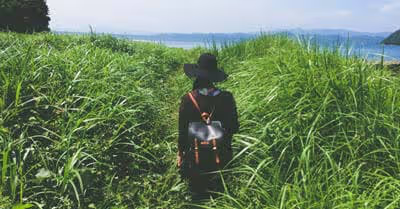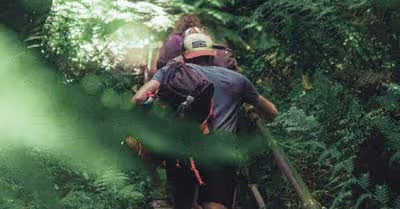Table of Contents
Are the original Timberlands good for hiking?
If you are lucky enough to own an original pair of timberlands, I have some bad news for you; they are not ideal for hiking at all. They may look like they are up to the job, but that’s about it. They simply don’t offer the support and comfort needed for long hikes.
When you are hiking, there are a few things that your shoes need to do. Most of all, they need to protect your ankles and keep you comfortable. Original Timberlands fail to do any of these things. They are too tough and unforgiving. This isn’t so much the fault of Timberland themself but the era they came from. Originally, hiking boots were designed to be rigid and strong. This made them unforgiving.
The idea was that it protected your ankle from rolling or being damaged by debris on the trail. In theory, this is great. In practical terms, it is far from ideal. If your ankle can’t move at all in your boot you are far more likely to break it. If you catch your foot in something and fall instead of your ankle adjusting/moving as you fall it will instead just break. Thicker, heavy, material is also exhausting for you to walk around with. Carrying an extra 15 pounds on your feet may not seem like too much of a problem at first, but it starts to quickly add up. In no time at all your feet, ankles and legs will begin to ache far more than they would with a lighter pair of boots.
Are the newer Timberlands good for hiking?
Newer Timberlands are far better for hiking than their original counterpart. This is mostly because they are made from lighter material and have a much softer inside. Over long hikes, your feet are not going to be anywhere near as tired as they would with the originals. They offer enough protection and sturdiness without sacrificing mobility and maneuverability. Plus, newer Timberlands have furry/fluffy insides. This can help keep your feet warm and comfortable in cold weather. In hot weather, this is a different story. All of that fluff and fur will absorb any sweat and moisture that is in your shoes and start to make you very uncomfortable. It will not only make your shoes smell AWFUL, but they will begin rubbing on your feet. When you sweat your feet are already more prone to blisters and soreness, rubbing wet wool on them is only going to make matters worse. Many avid hikers choose to wear Timberlands for short hikes. After all, they look good. Sometimes, for some people, that’s what matters most. However, most experienced hikers will choose to wear a specific brand of hiking boots rather than generic outdoor footwear.
Are there any downsides to wearing Timberlands when hiking?
As mentioned above, there are numerous downsides. Of course, you have the above-mentioned drawbacks but there are some more to consider. When you compare Timberlands to the alternatives you start to see how problematic they are. They simply don’t do anything well, most often when you are comparing two things it is because they each do something different very well. You may have one pair of hiking boots that will give you a lot of support but isn’t ideal for warm weather conditions. You may have another pair that is great for keeping your feet warm but doesn’t do so well at keeping them dry. Timberlands don’t do anything very well, they do a few things averagely. They offer you okay support but they can cause injuries because there is no give. They are relatively comfortable, but they cost a small fortune. You get the idea. If you choose to wear Timberlands the chances are you are wearing them as a fashion statement, not for their practical benefits. There is a reason hipsters wear Timberlands and hikers generally don’t.
What makes a good pair of hiking boots?
A good pair of hiking boots support your feet, protect your ankles, keep you warm, breathe well, and are affordable. If your hiking boots don’t have high tops they are not going to give you the necessary ankle support when traversing steep parts of the trail. If you are hiking through the chilly north, your boots need to be well insulated. Whether this is with a poly-nylon blend or with wool depends on preference. Wool will be warmer, but it absorbs water like crazy. Regardless of the climate that you are hiking in, how well your boots breath is something you may want to consider.
If your feet are going to get hot and sweaty you want some decent air circulation so they don’t fill with moisture and begin to smell. Even in very cold conditions if your boots don’t breathe you are going to suffer the consequences. Sure, while you are hiking your warm boots will be no problem even if they are very damp inside. But, what about when you stop hiking? Whether it’s for lunch or the night, your feet will cool down and now you have wet feet in freezing conditions. This is a good way to get hypothermia. Or at the very least a cold.
Affordability also plays a part. Hiking boots are designed to be sturdy and long-lasting. Most of them do last a long time; but not forever. Eventually, your hiking boots are going to wear down. When this happens you will either need to have them professionally repaired or replace them altogether. This isn’t necessarily a problem, it is just something to think about. If you are going to need to repair your boots every few years, or worse replace them, you won’t want to be buying overly expensive ones. Unless money isn’t an issue. For most people though, it is.
Do I need to wear hiking boots?
Whether you truly need to wear hiking boots has been a topic of contention in the hiking community for a long time. It can even get pretty heated depending on who you ask. The simple answer is, it depends. It depends on who you are, where you are hiking, and how long you are hiking for. If you are only planning on hiking for a few hours over very flat terrain. No, you probably don’t need hiking boots. Normal running shoes will do just fine. If you are going to be hiking on a very rough trail up a very steep incline, then yes you need hiking boots. If you are planning on jogging rather than walking, you cant wear hiking boots. Hiking boots intentionally limit your ankle movement. This stops them from rolling or being sprained easily. This also means it is impossible to run. You cant get the spring in your step needed to run without bending your ankles. If you don’t mind looking goofy, you could try jogging around your home right now with flat feet. It doesn’t look right, feel right, or work at all to be perfectly honest.
Do I need to wear hiking socks?
Hiking socks serve a few purposes. Whether or not you need them depends largely on how long you are hiking for and what the weather is like. The first reason you may want to wear hiking socks is that it is cold. Hiking socks are thicker and are far better at keeping your feet warm than dress socks. Additionally, hiking socks can protect your feet better from rubbing on your boots. The friction caused by rubbing can hurt. Not only is it initially painful but it can lead to more long-lasting complications. Blisters, infections, and even bleeding. Anyone who has been forced to finish their hike with blisters can attest to how awful they are. Lastly, hiking socks help your boots fit more comfortably. They fill the gap between your feet and the boots. This means there is still room for your feet to move if needed, but they won’t be slipping around. This is why it is so important to try hiking boots on in the store whilst wearing hiking socks.
Conclusion
Hopefully, this article has answered any questions you may have had about Timberlands and how good they truly are for hiking. They will get the job done if you are only walking short distances, and doing so infrequently. If you are planning on hiking often and far, get some proper hiking boots. There is nothing wrong with choosing Timberlands because they look good. We all like to dress nicely. But hiking isn’t about what you wear, it’s about where you go and what you see. You are hiking for the views of nature. Not the views of your feet.
Recent Articles
















